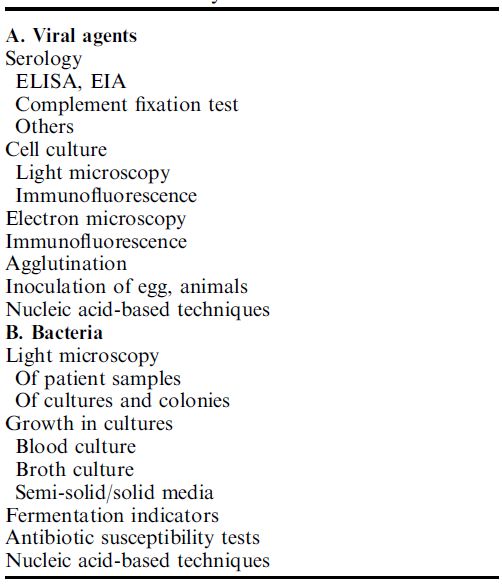


 النبات
النبات
 الحيوان
الحيوان
 الأحياء المجهرية
الأحياء المجهرية
 علم الأمراض
علم الأمراض
 التقانة الإحيائية
التقانة الإحيائية
 التقنية الحيوية المكروبية
التقنية الحيوية المكروبية
 التقنية الحياتية النانوية
التقنية الحياتية النانوية
 علم الأجنة
علم الأجنة
 الأحياء الجزيئي
الأحياء الجزيئي
 علم وظائف الأعضاء
علم وظائف الأعضاء
 الغدد
الغدد
 المضادات الحيوية
المضادات الحيوية|
Read More
Date: 12-10-2015
Date: 28-10-2015
Date: 11-10-2015
|
Classical Microbiological Diagnosis
Microbiological diagnosis is involved with the detection of different classes of disease causing agents such as viruses, bacteria, fungi and many types of parasites. The mainstay of diagnosis still is the clinical history and the physical signs of the patient. However, ever since bacteria were recognised as disease-causing agents in the 1860s, clinicians have relied on supplementary laboratory tests for the confirmation of a tentative diagnosis, including microscopy, colony growth on agar plates and growth in liquid cultures supplemented with different types of chemical indicators (Table ).
The focus will be on nucleic acid-based microbiological diagnostics. Viruses are too small to be observed through the light microscope. Instead, the electron microscope is useful for the identification of viruses that cause diarrhoea and poxviruses that cause warts and other skin lesions. However, electron microscopy is hampered by its low sensitivity and the work required to prepare and examine electron micrographs. Agglutination tests are still used to detect, e.g., adenovirus or rotavirus antigens in diarrhoea, but the sensitivity of this and other immunological methods is too low in most other viral diseases. Inoculation of a permissive cell culture by infected patient materials yields an efficient biological amplification of the virus, but growth takes days and different viruses require different cell types for efficient propagation, and many viruses may not grow in cell cultures at all – again limiting the speed and efficacy of diagnosis. Serological methods detect specific antibodies made by the immune system of the patient as a response to the disease causing agent or detect specific viral antigens. Serology still dominates routine diagnostics in virology. ELISA and EIA techniques have vastly improved the sensitivity, speed and accuracy of serology, but none of the serological techniques can circumvent the fact that it often takes from days to weeks following acute disease until detectable levels of antibodies are present in the circulation. In some viral diseases, usually when the incubation time is longer, such as in the case of rubella or parvovirus B19 infections, the appearance of specific antibodies coincides with the appearance of clinical signs such as skin rashes. In these cases, serology is an excellent and adequate diagnostic tool.
Table . Classical methods in the microbiology laboratory.

Nucleic acid amplification techniques, of which PCR represents the prototype, have entirely changed the basis of virological diagnosis and thereby the acute differential diagnosis of infectious diseases. The main reason is the possibility of detecting the nucleic acid of the causative agents directly, rapidly, specifically and with very high sensitivity.
Nucleic acid-based techniques present, however, a number of technical challenges on their own. Due to extreme sensitivity, the amplification techniques are susceptible to contamination and their dependence on exact nucleic acid sequences may cause the tests to fail due to natural sequence variability or new mutations in critical nucleic acid sequences of the agent. The remainder of this chapter will be devoted to microbiological nucleic acid-based techniques, their principles, the applicability and remaining challenges and trends.



|
|
|
|
اكتشاف تأثير صحي مزدوج لتلوث الهواء على البالغين في منتصف العمر
|
|
|
|
|
|
|
زهور برية شائعة لتر ميم الأعصاب التالفة
|
|
|
|
|
|
بوقت قياسي وبواقع عمل (24)ساعة يوميا.. مطبعة تابعة للعتبة الحسينية تسلّم وزارة التربية دفعة جديدة من المناهج الدراسية
|
|
|
|
يعد الاول من نوعه على مستوى الجامعات العراقية.. جامعة وارث الانبياء (ع) تطلق مشروع اعداد و اختيار سفراء الجامعة من الطلبة
|
|
|
|
قسم الشؤون الفكرية والثقافية يعلن عن رفد مكتبة الإمام الحسين (ع) وفروعها باحدث الكتب والاصدارات الجديدة
|
|
|
|
بالفيديو: بمشاركة عدد من رؤساء الاقسام.. قسم تطوير الموارد البشرية في العتبة الحسينية يقيم ورشة عمل لمناقشة خطط (2024- 2025)
|